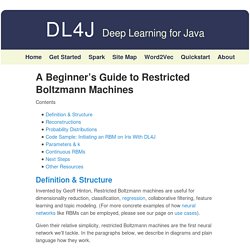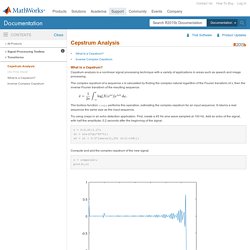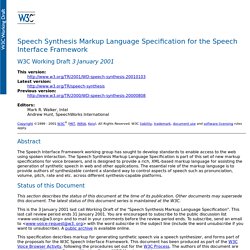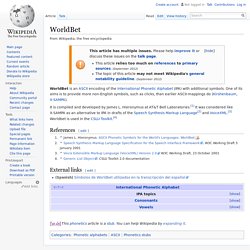

Open-source, distributed deep learning for the JVM. Contents Definition & Structure Invented by Geoff Hinton, Restricted Boltzmann machines are useful for dimensionality reduction, classification, regression, collaborative filtering, feature learning and topic modeling.

(For more concrete examples of how neural networks like RBMs can be employed, please see our page on use cases). Given their relative simplicity, restricted Boltzmann machines are the first neural network we’ll tackle. In the paragraphs below, we describe in diagrams and plain language how they work. RBMs are shallow, two-layer neural nets that constitute the building blocks of deep-belief networks. Each circle in the graph above represents a neuron-like unit called a node, and nodes are simply where calculations take place. That is, there is no intra-layer communication – this is the restriction in a restricted Boltzmann machine. Each visible node takes a low-level feature from an item in the dataset to be learned. Activation f((weight w * input x) + bias b ) = output a. Links to tools — emime.org. Cepstrum Analysis - MATLAB & Simulink - MathWorks United Kingdom. What Is a Cepstrum?

Cepstrum analysis is a nonlinear signal processing technique with a variety of applications in areas such as speech and image processing. The complex cepstrum of a sequence x is calculated by finding the complex natural logarithm of the Fourier transform of x, then the inverse Fourier transform of the resulting sequence: The toolbox function cceps performs this operation, estimating the complex cepstrum for an input sequence. It returns a real sequence the same size as the input sequence. Try using cceps in an echo detection application. T = 0:0.01:1.27; s1 = sin(2*pi*45*t); s2 = s1 + 0.5*[zeros(1,20) s1(1:108)]; Compute and plot the complex cepstrum of the new signal. The complex cepstrum shows a peak at 0.2 seconds, indicating the echo.
Tutorials on topics in 1D Signal Analysis. Asr:wfst [CMUSphinx Wiki] Audio Signal Processing with MATLAB and Simulink - MATLAB - MathWorks United Kingdom. Audio signal processing is the application of digital signal processing (DSP) techniques to audio, speech, and music signals.

DSP System Toolbox™ provides streaming signal processing, low latency multichannel audio I/O, and a library of ready-to-use algorithms and filter design tools for audio signal processing with MATLAB® and Simulink®. The toolbox can also be used for real-time audio signal processing. DSP System Toolbox combines stream processing techniques with multichannel real-time audio capture to provide a unified framework for simulation and execution of real-time audio processing on the desktop. This framework allows you to quickly model and validate real-time audio system designs before deployment. Transcriber: Development and use of a tool for assisting speech corpora production. A Spoken Language Processing Group, LIMSI-CNRS, BP 133, 91403 Orsay Cedex, Franceb DGA/CTA/GIP, 16 bis av.

Prieur de la Côte d'Or, 94114 Arcueil Cedex, Francec LDC, 3615 Market Street, Suite 200, Philadelphia, PA 19104-2608, USA Accepted 2 August 2000, Available online 28 November 2000 Choose an option to locate/access this article: Check if you have access through your login credentials or your institution Check access Get rights and content Abstract We present “Transcriber”, a tool for assisting in the creation of speech corpora, and describe some aspects of its development and use. Résumé Nous présentons “Transcriber”, un outil d'aide à la création de corpus de parole, et nous décrivons des éléments de son développement et de son utilisation.
Keywords Transcription tool; Speech corpora; Broadcast news; Linguistic annotation formats Copyright © 2001 Elsevier Science B.V. Speech Synthesis Markup Language Specification. Abstract The Speech Interface Framework working group has sought to develop standards to enable access to the web using spoken interaction.

Unicode/UTF-8-character table. Www.cslu.ogi. WorldBet. WorldBet is an ASCII encoding of the International Phonetic Alphabet (IPA) with additional symbols.

One of its aims is to provide more non-English symbols, such as clicks, than earlier ASCII-mappings do (Kirshenbaum, X-SAMPA). It is compiled and developed by James L. Hieronymus at AT&T Bell Laboratories.[1] It was considered like X-SAMPA as an alternative to IPA in drafts of the Speech Synthesis Markup Language[2] and VoiceXML.[3] Worldbet is used in the CSLU Toolkit.[4] References[edit] External links[edit] (Spanish) Símbolos de Worldbet utilizados en la transcripción del español.
Login required. By logging in to this service, you are agreeing to the following Regulations and Policies.

If you do not understand any of the Regulations or Policies, or if you do not agree to fully abide by them, then you should not use this service. Specifically, you must ensure that you keep your login details confidential and you may not allow any third party to use your account. All login attempts are monitored and all suspicious account activity is investigated. In extreme circumstances, your network account may be disabled. If you are using the University of Huddersfield's network to use this service, then you are also agreeing to abide by the JANET Acceptable Use Policy.
Students of the University of Huddersfield are also implicitly bound to abide by the relevant Handbook of Regulations issued during enrolment. The exernal online subscription resources made available to you by the library may also have their own separate terms & conditions and you are encouraged to read them. UCL Speech, Hearing & Phonetic Sciences - Internet Shopping. Description The EUROM1 database contains recordings of 60 speakers in each of seven European Languages: Danish, Dutch, British English, French, German, Norwegian and Swedish.

It was explicitly designed to aid the phonetic comparison of languages, with similar materials and recording protocols in all languages. The EUROM1 corpus was collected by the "Enabling Technology and Research" working group within ESPRIT-project 2589 "Speech Assessment Methodology". A compatible Italian database and compatible databases in Eastern European languages are available from the European Language Resources Association. Overview. Backbone - Pedagogic Corpora for Content and Language Integrated Learning.